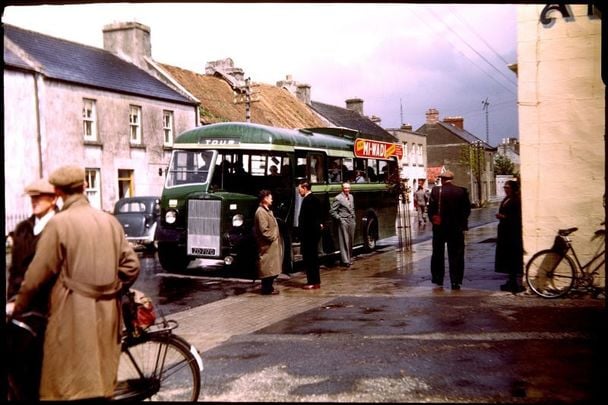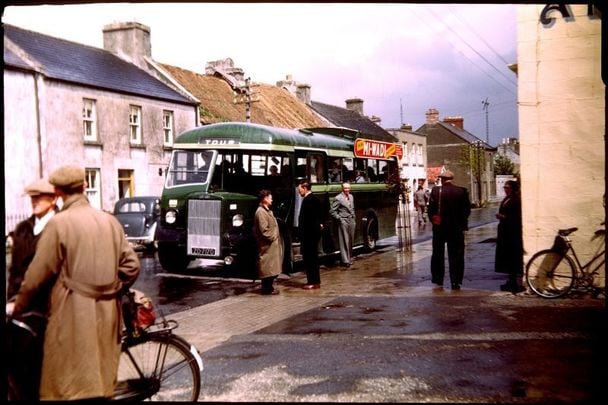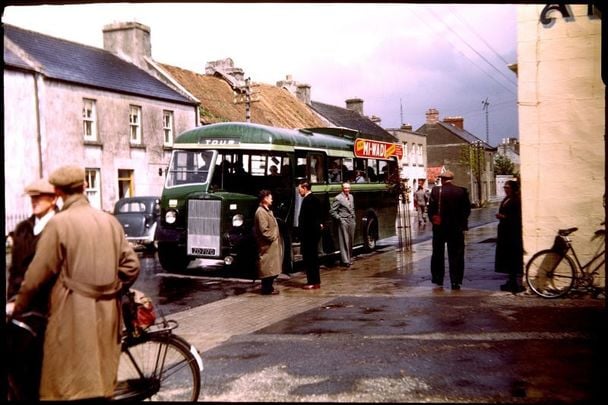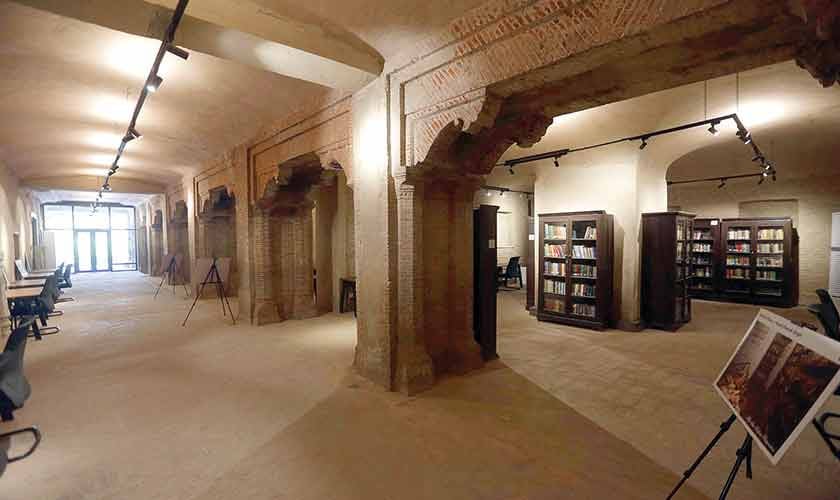A Savvy Traveler’s Journey: Ireland 1953
In 1953, a savvy traveler from rural Minnesota prepared for an unforgettable journey to Ireland, packing a portable 35mm camera, Kodachrome slide film, and other essentials for world travel. That traveler was my father, Martin J. Walsh Jr., affectionately known as Marty to distinguish him from his father, Martin J. Walsh Sr. Before embarking on his trip to the island of Ireland, Marty documented his experiences with his Clarus 35mm camera and Kodachrome film—the first known return trip home to Ireland by our family.
### Roots in Rural Minnesota
A native of Murdock, Minnesota, my father was 28 years old at the time and working as a railroad telegrapher, communicating via Morse code for the Great Northern and later the Burlington Northern Railroad (1943–1984). Our family settled in De Graff, a small rural community in Swift County, Minnesota, founded in the late 1800s.
De Graff was one of ten villages established across five counties in western Minnesota under the guidance of Saint Paul Archbishop John Ireland. The Archbishop worked to help Irish Catholic families like mine escape the urban slums of the mid-19th century by resettling them on farmlands in rural Minnesota. Growing up, my father would often say, “We are Archbishop John Ireland’s people,” noting the curious coincidence that the Archbishop’s last name was the same as the country our ancestors had left behind.
My family was among approximately four thousand Catholic families Archbishop Ireland helped resettle during 1875–1885 in west-central and southwest Minnesota. Today, I live just three miles from De Graff, in Murdock—the very house where my father was born in 1924.
For more on De Graff and the historic Church of St. Bridget, visit the United States Department of the Interior, National Park Service website. The Library of Congress in Washington, DC, also offers detailed presentations on Irish-Catholic immigration to America for those interested in exploring the topic further.
### Capturing Memories with Kodachrome
Though my father was not a professional photographer, his incredible 1953 Kodachrome images have survived, providing a vivid glimpse into his journey to Ireland. His love of travel and photography passed on to my brother, Paul M. Walsh, and me—both of us worked as photojournalists and pursued careers in photography and media.
Thanks to his detailed photographic record, I know more about my father’s travels than I ever could have otherwise. You can view many of Martin J. Walsh Jr.’s photos of Ireland here on [Flickr].
I imagine my father as a proud young man, thrilled to have the opportunity to see the homeland of his family in Ireland. One of his Kodachrome slides, dated May 16, 1953, features the handwritten note: “My pockets full,” hinting at the important travel items he carried.
### A Glimpse into 1953: Passport and Early Travel
My father’s U.S. Passport, issued on February 6, 1953, describes him as 5 feet 11 inches tall, with brown hair and hazel eyes, born in Murdock, Minnesota, working as a telegraph operator. Interestingly, while not listed on the passport, my father often referred to himself as “Black Irish”—a term used outside Ireland to describe Irish descendants with black hair and dark eyes, sometimes theorized to have Spanish lineage from shipwrecked traders. Though my father was clearly Caucasian with freckles (carrying rare red hair genes), he embraced that identity as part of our family lore.
At the time of his journey, my father was unmarried and likely living at home to save money for the trip of a lifetime. Traveling to Europe had only recently become accessible following World War II. According to my grandfather’s diary, my father left by train from Willmar, Minnesota, before eventually flying to Belfast, Northern Ireland.
### Transatlantic Travel and Early Refueling Stops
My father’s itinerary included a necessary refueling stop at Gander, Newfoundland, Canada, a crucial early postwar transatlantic air route waypoint. Interestingly, the Gander airport later became a designated alternate landing site for NASA’s Space Shuttle program due to its strategic location and runway capacity.
For a man accustomed to prairie farmlands and rural Minnesota, flying across the Atlantic must have felt like space travel.
### Exploring Ireland: Family Roots and Stunning Landscapes
Once in Ireland, my father’s photographic adventures took him to Killarney in County Kerry—the origin of much of our family’s Irish heritage. Though he didn’t locate the exact family farm I discovered in 2018 (Dromkerry townland, County Kerry), his images included stunning views of the Gap of Dunloe, the Lakes of Killarney, and the majestic MacGillycuddy’s Reeks and Purple Mountain ranges.
He documented a three-hour pony and trap ride through the Gap of Dunloe and captured images of the railway station, mountain landscapes, and countryside vistas.
### Dublin and Beyond
During his stay in Dublin, Martin stayed across from Saint Stephen’s Green at the Shelbourne Hotel. From his hotel room window, he photographed the famous park, noting it was “taken after a rain.” His journeys around Ireland included train and tour bus trips to Galway, Limerick, and other locations associated with the classic 1952 film *The Quiet Man*—starring John Wayne, Maureen O’Hara, and Barry Fitzgerald.
His Kodachrome slides feature notable sites such as John Wayne’s house and other filming locations in Galway. I suspect it was this film that sparked my father’s interest in traveling to Ireland and exploring his roots.
In a meaningful coincidence, during my stay at the Shelbourne Hotel in January 2019, I watched *The Quiet Man* from my hotel room—a luxury unimaginable during my father’s 1953 journey. While I had a courtyard view and an Irish flag visible from the rooftop, my father had a direct view over Saint Stephen’s Green.
### About the Author
Jannet L. Walsh, of Murdock, Minnesota, is a photographer, writer, and educator. She is the author of the forthcoming creative nonfiction quest narrative *Higgledy-Piggledy Stones: Family Stories from Ireland and Minnesota,* scheduled for publication in 2022 by Shanti Arts Publishing. Jannet also compiled the *Irish Genealogy Toolkit,* a resource list for those researching Irish heritage.
You can follow Jannet Walsh on [Facebook](#) and [Twitter](#).
—
*Originally published in 2022, updated in September 2025.*
https://www.irishcentral.com/opinion/others/ireland-images-kodachrome



